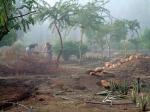
general plan dry garden
Six years ago the idea for a Dry Garden was launched for a piece of bare land with a surface of approx. 1500 square metres. It was the most brackish part of our 10 hectare (25 acres) property and soil analysis in The Netherlands showed a pH of 8.3 and an organic content of 3 percent next to numerous deficits of nitrogen, phosphorous and diverse trace elements. We choose for the organic and slow way in improving the soil by deminishing the brack and bringing the pH down to 6.8 by adding coarse river sand and plenty of compost in the top 50 cm of the existing (too clayish) soil. After that we soaked everything a few times to get the brack level down (<40ppm; was 200 ppm). And than again mixing compost and gritsand through the top 30 cm of the soil. Considering that it takes approx. 3 years before the new soil (micro-organisms, etc.) is established we waited that long before we made the first trials with some cacti, other succulents and some acacia species including acacia hybrids.

preparation works
This year we made the final decision and two students (Pauline Gillet and Sybille de Cussy) from the landscape university in Blois, France (ENSNP) have been fully engaged in designing the garden and implementing their design in practice.
De Cussy and Gillet knew literally nothing about succulent plants and lack of knowledge often results in an unusual surprising approach.

artist impression of aloe bush
They created a dry garden with 7 spheres (totalling 78 different species, subspecies, etc.); creeping plants, shrubs/trees, rocks, cactus and euphorbia bushes, aloe bush, mixed border, agaves.

rock art in the dry garden
Students of the McGregor Waldorf School were engaged in rock art drawings throughout the garden as part of Land Art Project in South Africa that is initiated by Soekershof.

detail of aloe bush
A PDF-file with plan and plantlist is -free of charge- available for interested landscapers and other interested parties with simular soil ‘problems’. Request e-mail to info -at- soekershof.co.za